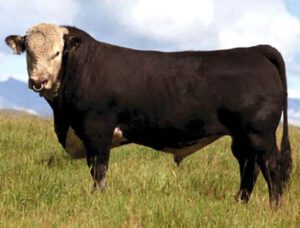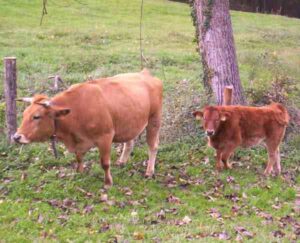The Holstein Friesian cattle is a breed of dairy cattle originating from the Dutch provinces of North Holland and Friesland, and Schleswig-Holstein in Northern Germany. The breed’s name is often shortened to ‘Holsteins‘ in North America. But the term ‘Friesians‘ is often used in the United Kingdom and Ireland. Currently, it is known as the world’s highest-production dairy animals.
The Dutch and German breeders bred and oversaw the development of the breed with the goal of obtaining animals that could best use grass (the area’s most abundant resource). Over the centuries, the result was a high-producing, black-and-white dairy cow.
Currently, the Holstein Friesian cattle is the most widespread cattle breed in the world. And today the breed is present in more than 150 countries. In Europe, the Holstein Friesian breed is used for meat in the south, and milk in the north. And since 1945, the European national development has led to cattle breeding and dairy products becoming increasingly regionalized.
More than 80% of dairy production is north of a line joining Bordeaux and Venice, which also has more than 60% of the total cattle. This change led to the need for specialized animals for dairy (and beef) production. Until this time, milk and beef had been produced from dual-purpose animals. The breeds, national derivatives of the Dutch Friesian, had become very different animals from those developed by breeders in the United States, who used Holsteins only for dairy production.
Breeders imported specialized dairy Holsteins from the United States to cross with the European black and whites. For this reason, in modern usage, “Holstein” is used to describe North or South American stock and its use in Europe, particularly in the North. “Friesian” denotes animals of a traditional European ancestry, bred for both dairy and beef use. Crosses between the two are described by the term “Holstein-Friesian”.[1]
Characteristics
The Holstein Friesian cattle are very beautiful animals. They have distinctive markings, usually black and white or red and white in coloration.
In some rare occasions, some animals have both black and red coloring with white. Red factor causes this unique coloring.
Blue is also a known color of these cattle. Blue color is produced by white hairs mixed with the black hairs giving the cow a bluish tint. This coloring is also known as ‘blue roan’ in some farm circles.
The Holstein Friesians are medium in size. Typically a mature cow weights between 680 and 770 kg. And a healthy calf weights between 40 and 50 kg.
Uses
The Holstein Friesian cattle is actually a dual-purpose breed. It is used for both meat and milk production purpose. But in some countries, the breed is known for it’s high milk production.
Special Notes
The Holstein Friesian cattle are extremely hardy and strong animals. They can adapt themselves to a wide variety of agro-climatic conditions. That’s why they are available throughout the world in more than 150 countries.
The breed is very popular mainly for it’s high milk production. A cow on average can produce about 10,200 kg of milk per year. Their milk is of pretty good quality containing 3.7 percent of butterfat content and about 3.1 percent protein.
Generally, breeders plan for Holstein heifers to calve for the first time between 21 and 24 months of age and 80% of adult body weight. The gestation period is about nine and a half months.
However, read some more information about this breed in the table below.
| Breed Name | Holstein Friesian | |
| Other Names | Known simply as Holsteins & Friesians in some areas | |
| Breed Purpose | Both milk and meat | |
| Special Notes | Good behavior and temperament, known for their hardiness and their ability to convert grass into milk efficiently, able to adapt a wide variety of climates, very good for milk production, milk is of pretty good quality, the breed is also good for meat | |
| Breed Size | Medium | |
| Bulls | Between 680 and 770 kg | |
| Cows | Between 680 and 770 kg | |
| Climate Tolerance | All climates | |
| Coat Color | Generally black and white patched coat, occasionally red and white | |
| Horned | Yes | |
| Milk Yield | Good | |
| Rarity | Common | |
| Country/Place of Origin | Netherlands, Germany |






